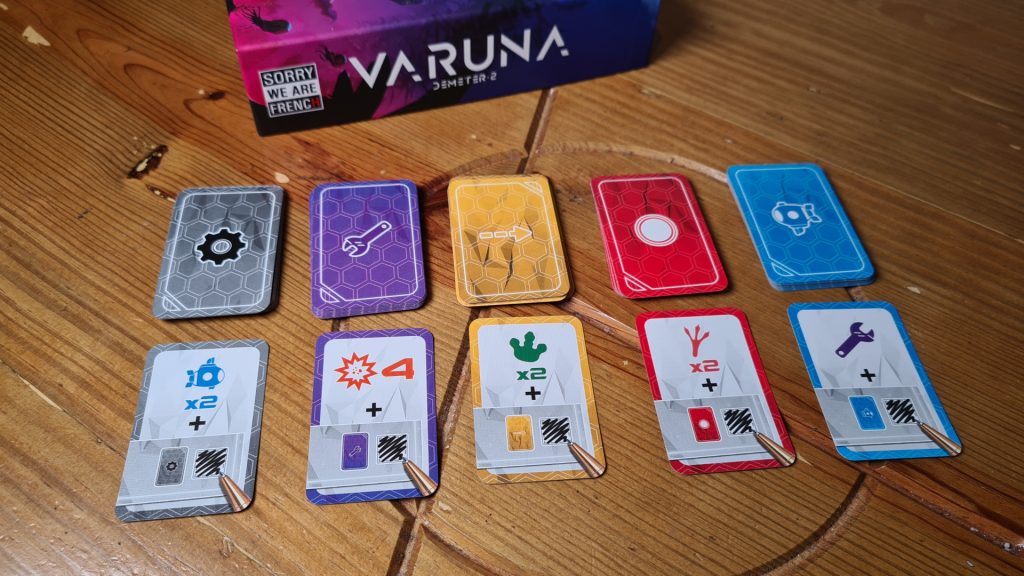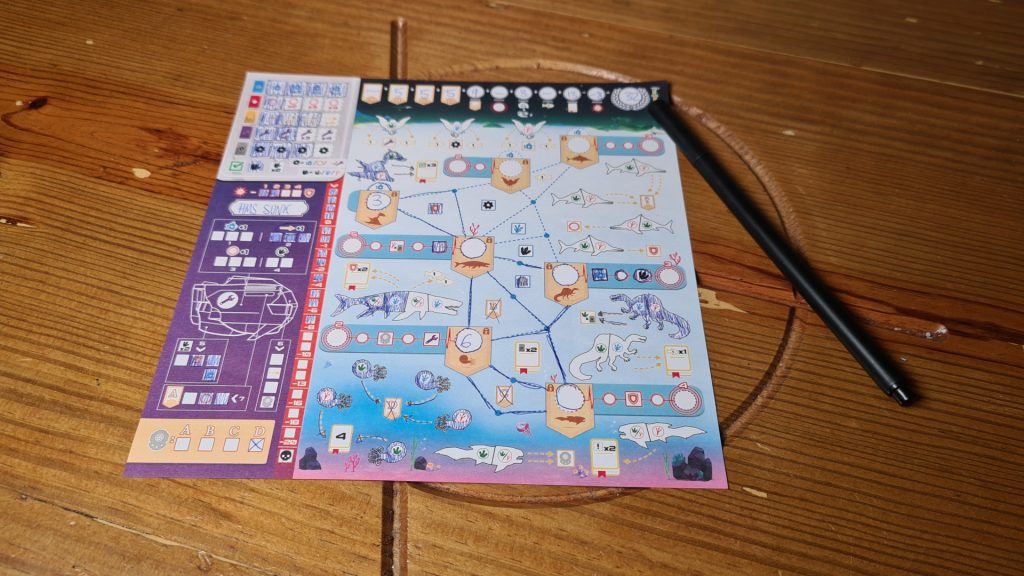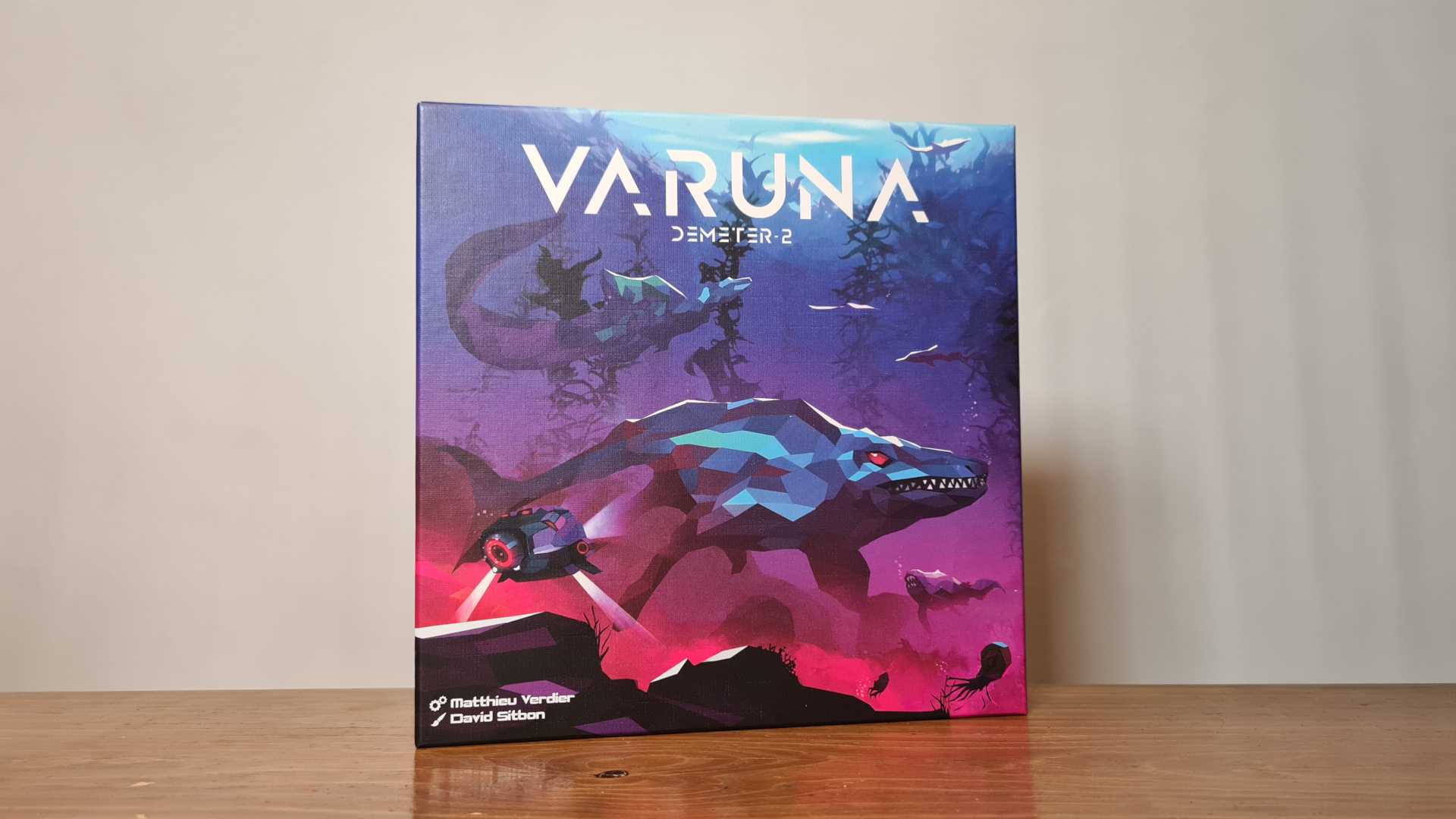Varuna is the brand new flip and write board game, from publisher Sorry We Are French. Designed by Matthieu Verdier, featuring artwork from David Sitbon, this is the sequel to Demeter and is another title set in the publisher’s Ganymede universe. Varuna is the second moon of Ganymede that needs to be explored – though this time around dinosaurs swim in it’s seas not roam on the surface. With dangerous exploration ahead of the players, is this a flipping good game to play? Let’s find out!
Once again as a scientist, you are tasked with heading off to one of the Ganymede moons; this time to the oceanic moon, Varuna. Scientists will choose where to land and pilot submarines, as they discover dinosaurs – from Mosasaurus to Dunkleostus. Research is still important though, especially with the potential for submarines to be damaged or even eliminated!
Taking a scoresheet players first need to select their starting location from one of three options. Shuffling the coloured decks, two cards are removed from each – leaving 5 decks of 13 cards. Across the 13 rounds of Varuna players will start by flipping over the top card of each deck and choosing one to use. Note that all players can select the same card to activate, or different ones.
Before taking any actions the players check to see if they take any damage. They sum up the damage values on the cards they didn’t choose, subtract their current shield level and take the remaining as damage. Damage is recorded on a track at the side of the scoresheet, and reaching sections down the tracker will lose the player increasingly more points. Getting to the bottom of the damage tracker sees the player instantly eliminated.

Players then activate the actions of the card they selected and trigger the bonus action based on the colour card chosen. The submarine icon represents a movement. This lets the player draw a line from either their start point or continue on from any line they’ve previously drawn to move their sub around. This is one way extra species can be found, enabling them to be discovered. The red sonar is the next possible main action. This could be used to find a deep down species, or use the sonar on a known area to find more out and trigger indicated bonus actions.
Discovering dinosaurs via the footprints that come out of the deck is similar to Demeter, however the species must have been unlocked via sub or sonar first. This sees a play shade in a section of a dinosaur, discovering it when it’s fully shaded. Fully shaded dinosaurs can then be studied – the yellow action. Studying can unlock points, one time bonuses to trigger or both.
The purple action is to upgrade your submarine, across 7 different possible rooms. These range from the engine room which allow the player to move an extra time when triggering the move sub action, through to gaining shields that protect the submarine. Objectives are handled differently from those in Demeter. When a player triggers an objective, perhaps from piloting their sub around the area with the Objective B icon, they instantly validate it – scoring points according to the randomly selected objective tile.
Objectives range from having upgraded rooms on the submarine to how many blue dino footprints you’ve used to discover with. These flip over making them harder for other players. For example, for 5 points the first player needs to have studied 3 – 5 fish, later on the other players need 4 – 6 fish. These objectives aren’t the only way to score points. Discovery tokens can trigger bonus actions, but also score depending on the different species you’ve discovered at the end of the game and there are also bonuses for fully discovering a species.
Once everyone has used the action on the card they chose, and then used the bonus based on the card colour, the round is over and the next lot of cards are flipped over. At the end of the 13th round it’s time to score up points. Combining the points from scored objectives, discoveries, completed species, sonars and even collected fish, then subtracting points based on your level of damage, whoever has scored the most wins. In the case of a tie, both players share the victory.

Much like it’s predecessor Demeter, Varuna is a combo heavy flip and write experience. With every card chosen at least 2 actions are performed, the card and the colour’s bonus. This is before players move their submarine around an area or cross off the next sonar section and trigger another bonus. Coming from playing Demeter straight into Varuna the comboing is about on the same level, though it is a lot more complex compared to roll & writes such as Ganz Schön Clever or Lost Cities. They have combos that trigger shading in another box here or there. Varuna has combos that could properly chain together or result in the player able to discover another dinosaur type or score an objective.
Part of what allows the game to be full to the brim with combos is the iconography. Without the use of so many symbols then there wouldn’t be space on a playsheet twice the size of what it is. The amount is daunting to new players, though those that have played and enjoyed Demeter will come into the experience aware of how quickly the sea of icons becomes easily readable. It might take a game to become comfortable with them. Still, it is well worth it and in your second play you’ll be almost confused as to how it was daunting in the first place.
The potential for your submarine to take damage, losing you points and maybe even seeing you eliminated from the game, is a huge part of Varuna. It drives decisions and backs players into a corner, forcing them to knowingly take sub-optimal moves. It also adds a risk factor to taking too many of one colour of card. Every time the cards are flipped there’s the worry a lot of damage is going to come out of the decks, especially when players get low down the tracker. At the end of the game though it’s your fault how many points are lost, as selecting the cards negates damage and players can gain shields to mitigate a lot.
Varuna isn’t just another Demeter, as it offers a very different set of combos to be triggered in a new variety of ways. Having multiple starting locations is a rather new choice to make in a flip and write, and the choices only start there. The potential for damage to completely eliminate you or just cause a large loss of points makes you play differently, though points are always the aim. With many ways to score it’s easy to at least make some progress, whether that’s from piloting the submarine around or studying dinosaurs. Whether you’re a fan of Demeter or new to the Ganymede universe of games, Varuna offers a thinky, combo filled flip and write experience. It might not be for families but for gamers it’s a real dinosaur discovery.
(Editor’s Note: Varuna was provided to us by Hachette Boardgames UK for the review. The game is currently available from local board game stores! Find your local store here.)

